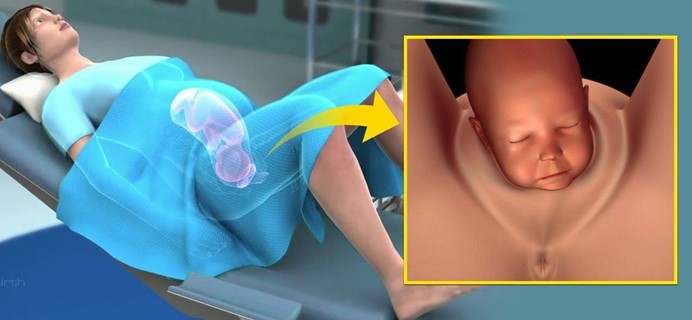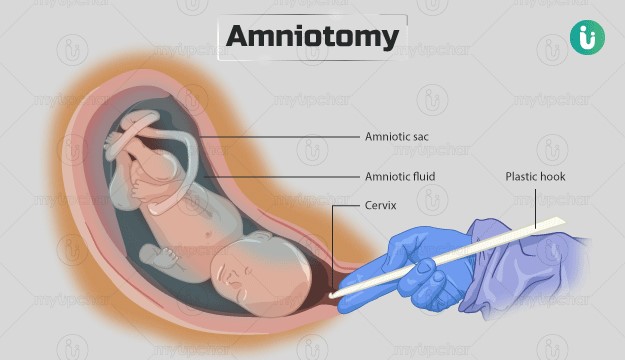A nurse is collecting data from a client who is 24 hr postpartum. Which of the following findings should the nurse expect?
Fundus soft, 2 fingerbreadths below the umbilicus
Fundus firm, 1 fingerbreadth below the umbilicus
Fundus firm, 4 fingerbreadths above the umbilicus
Fundus soft, to the right of the umbilicus
The Correct Answer is B
Choice A reason: Fundus soft, 2 fingerbreadths below the umbilicus is incorrect, as this finding indicates uterine atony and subinvolution. The fundus is the upper part of the uterus that can be palpated through the abdomen after birth. The fundus should be firm and midline to indicate adequate uterine contraction and involution. A soft or boggy fundus can increase the risk of hemorrhage and infection.
Choice B reason: Fundus firm, 1 fingerbreadth below the umbilicus is correct, as this finding indicates normal uterine contraction and involution. The fundus is normally at the level of the umbilicus immediately after birth and then descends about one fingerbreadth per day. A firm and midline fundus can prevent excessive bleeding and promote healing.
Choice C reason: Fundus firm, 4 fingerbreadths above the umbilicus is incorrect, as this finding indicates a higher than expected fundal height for a client who is 24 hr postpartum. The fundus is normally at the level of the umbilicus immediately after birth and then descends about one fingerbreadth per day. A high fundal height can indicate uterine atony, retained placental fragments, or bladder distension.
Choice D reason: Fundus soft, to the right of the umbilicus is incorrect, as this finding indicates uterine atony and bladder distension. The fundus should be firm and midline to indicate adequate uterine contraction and involution. A deviated fundus can indicate bladder distension, which can interfere with uterine contraction and involution and increase the risk of hemorrhage and infection.
Nursing Test Bank
Naxlex Comprehensive Predictor Exams
Related Questions
Correct Answer is ["B","C","E"]
Explanation
Choice A reason: Administer terbutaline if the fundus is boggy is incorrect, as this action is contraindicated for a client who has a boggy fundus. Terbutaline is a tocolytic agent that can relax uterine contractions and worsen uterine atony and hemorrhage. The nurse should administer oxytocin or other uterotonic agents as prescribed to stimulate uterine contraction and prevent bleeding.
Choice B reason: Observe the lochia during palpation of fundus is correct, as this action can provide information about the amount, color, consistency, and odor of lochia. Lochia is the vaginal discharge that occurs after birth, which consists of blood, mucus, and tissue. The nurse should observe the lochia during fundal palpation and report any abnormal findings, such as excessive bleeding, large clots, foul smell, or infection.
Choice C reason: Document fundal height is correct, as this action can provide information about the progress of uterine involution. The fundus is the upper part of the uterus that can be palpated through the abdomen after birth. The nurse should document the fundal height in relation to the umbilicus and note any changes over time.
Choice D reason: Massage a firm fundus is incorrect, as this action is not necessary for a client who has a firm fundus. A firm fundus indicates adequate uterine contraction and involution and prevents excessive bleeding. The nurse should massage a boggy or soft fundus until it becomes firm and midline.
Choice E reason: Determine whether the fundus is midline is correct, as this action can provide information about the position of the uterus and bladder. The fundus should be midline and not displaced to either side. A deviated fundus can indicate bladder distension, which can interfere with uterine contraction and involution and increase the risk of hemorrhage and infection. The nurse should assist the client to empty their bladder and reassess the fundal position.

Correct Answer is D
Explanation
Choice A reason: Check the client's temperature every 4 hr is incorrect, as this action is not frequent enough for a client who had an amniotomy. The nurse should check the client's temperature every 2 hr after an amniotomy, as there is an increased risk of infection due to the rupture of membranes. The nurse should also monitor for signs of chorioamnionitis, such as foul-smelling amniotic fluid, maternal tachycardia, or fetal tachycardia.
Choice B reason: Remind the client to bear down with each contraction is incorrect, as this action is not appropriate for a client who is in the active phase of the first stage of labor. The nurse should instruct the client to avoid bearing down or pushing until they are in the second stage of labor, when the cervix is fully dilated and effaced. Bearing down too early can cause cervical edema, lacerations, or exhaustion.
Choice C reason: Maintain the client in the lithotomy position is incorrect, as this action is not optimal for a client who is in the active phase of the first stage of labor. The lithotomy position is a supine position with the legs elevated and abducted, which can reduce blood flow to the uterus and placenta, increase perineal edema, and limit pelvic outlet diameter. The nurse should encourage the client to change positions frequently and use upright or lateral positions that can enhance uterine contractility, fetal descent, and maternal comfort.
Choice D reason: Encourage the client to empty the bladder every 2 hr is correct, as this action can promote labor progress and prevent bladder distension and infection. The nurse should assist the client to void every 2 hr after an amniotomy, as there may be decreased sensation of bladder fullness due to pressure from the fetal head. A full bladder can interfere with uterine contractions, fetal descent, and cervical dilation.

Whether you are a student looking to ace your exams or a practicing nurse seeking to enhance your expertise , our nursing education contents will empower you with the confidence and competence to make a difference in the lives of patients and become a respected leader in the healthcare field.
Visit Naxlex, invest in your future and unlock endless possibilities with our unparalleled nursing education contents today
Report Wrong Answer on the Current Question
Do you disagree with the answer? If yes, what is your expected answer? Explain.
Kindly be descriptive with the issue you are facing.
